Review
Printable
version
May
9, 2000
Announcements
-
Final
in room B130 Van Vleck 12:25pm--2:25pm Tuesday, May 16
-
cumulative
-
100
questions
-
BRING
CALCULATOR
-
Hand
in Homework #7
-
Hand
in Observing project
-
Extra
credit project due Friday
-
Slight
change in syllabus: review starts today
-
please
submit specific questions for Thursday
Review
Outline
-
The
big picture
-
The
solar system
-
the
Sun
-
9 planets
-
7 major
moons
-
Why
didn't we just start with Mercury?
-
intro
material
-
scientific
method
-
scientific
notation, units
-
astronomical
nomenclature
-
nature
of light and matter
-
Laws
of orbits, gravity
-
telescopes
-
Formation
of solar system
-
Earth
and moon in detail, other planets, moons by analogy
-
Specifics
about each planet (not quite as important)
-
Surface
features
-
atmosphere
-
internal
structure
The
Solar System Big Picture
-
Name
the 9 planets in order:
-
Mercury,
Venus, Earth, Mars, (asteroids), Jupiter, Saturn, Uranus, Neptune, Pluto,
(Kuiper belt, Oort cloud)
-
Know
the 7 major moons and which planet they orbit:
-
The
Moon: Earth
-
Io,
Europa, Ganymede, Callisto: Jupiter
-
Titan:
Saturn
-
Triton:
Neptune
-
Know
appearance of
-
Sun
-
Each
planet
-
typical
asteroid
-
comet
-
Less
important to know appearance of all of the 7 major moons BUT
-
know
that Io is very volcanic
-
Europa
has an active ice surface (ice rafts)
-
Titan
has a thick atmosphere
Sun
up close, far away (with sunspots)
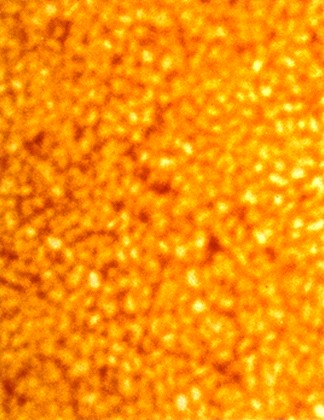

Mercury
(looks like our Moon)

Venus,
V-shaped clouds

Earth
compared to Venus, Mars

Mars

Asteroid
(Eros)

Jupiter

Saturn

Uranus,
Neptune, pluto (compared to Earth)

Comet
(Hale-Bopp)
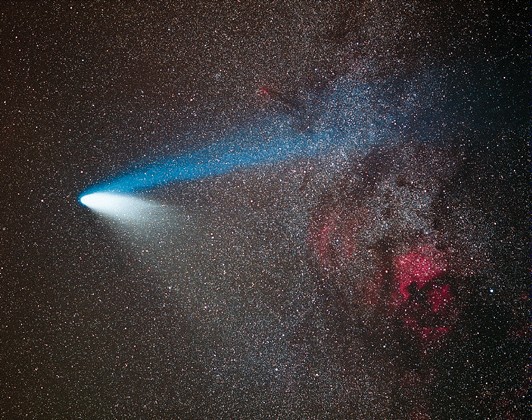
Io's
volcanically active surface

Europa's
Ice rafts

Titan's
thick atmosphere

Introductory
Material
-
Scientific
method
-
Observation
-
Hypothesis
-
Test under all circumstances
(if possible)
-
Check for unexpected results
-
Group of correct hypothesis
= theory
-
If observation disagrees
with hypothesis, modify hypothesis
-
Scientific notation, units
-
1 AU = 1.4960 x 108
km = 1.4960 x 1011 m
-
Astronomical nomenclature
-
diurnal motion
-
east to west daily motion
of stars, sun
-
really we rotate counter
clockwise
-
Celestial sphere, equator
-
Lined up with Earth's rotation
-
Ecliptic
-
Lined up with Earth's orbit
around Sun
-
Equinoxes (fall, spring),
Solstices (summer, winter)


Nature
of Light and Matter
-
Electromagnetic
radiation
-
Long
wavelength (red) low energy
-
short
wavelength (blue) high energy
-
Frequency
(n) to wavelength
(l)
n =
c/l
-
Frequency
(n) to energy
(E):
E
=
hn
-
c
= speed of light = 3 x 108 m/s absolute speed limit
-
h
= Planck's constant = 4.135 x 1015 eV s
-
h
= 6.626 x 10-34 J s (value given on final)
-
Each
element or molecule has its own unique set of spectral lines
-
recall
spectrum tubes (neon lights)
-
USING
SPECTRAL LINES, WE IDENTIFY ELEMENTS AND MOLECULES ON OTHER PLANETS, STARS,
ETC.
-
study
of spectra is "spectroscopy"
-
An
atom contains a dense nucleus and is surrounded by electrons
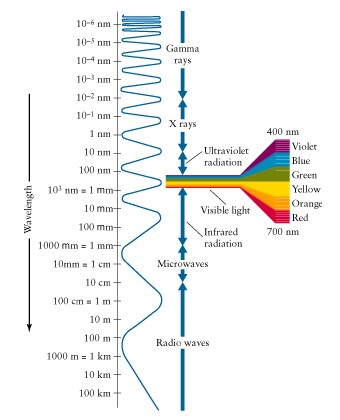


Laws
of Orbits, Gravity
-
Kepler's
Three Laws
-
Planets
orbit Sun in an ellipse
with the Sun at one focus
-
A line
joining the planet to the Sun sweeps out equal
areas in equal
intervals of time
-
P2
= a3 (Period,
semi major axis
--good for Sun only)
-
Newton's
universal law of gravitation

-
m1,
m2 masses of objects
-
R
separation distance
-
G = 6.67 x 10-11
newton m2/kg2
-
Newton's
form of Kepler's 3rd law (good anywhere)

Elliptical
orbit

Telescopes
-
Telescope's
primary goal is to collect light
-
the
bigger it is, the more light it collects
-
Two
basic types:
-
refracting
-- uses lenses
-
reflecting
-- uses mirrors
-
don't
need to know all subtypes
-
Can't
see out of atmosphere at all wavelengths of electromagnetic radiation
-
Need
to be above atmosphere for infrared and UV, X-ray, Gamma-ray
refracting
telescope design

reflecting
telescope design


Formation
of Solar System
-
Large cloud of hydrogen and
helium (stuff from big Bang)
-
Enriched with heavier elements
by star barf (supernova explosions)
-
Cloud self gravitates
-
rotates
-
collapses into central core
plus disk
-
planets form in disk from
collisions with planetesimals
-
collisions released a lot
of energy and heat
-
all planets used to be much
warmer
-
Inner (Terrestrial) planets
have less gas than outer (Jovian) planets because of proximity to hot sun
-
Analogy in Galilean satellites
with icy material

Earth
in Detail, other planets by analogy
-
Geology
-
Inner structure of Earth
studied by seismic waves
-
deduce dense elements (like
iron) sank when Earth was first formed (and hot)
-
Earth only planet with plate
tectonics
-
caused by convection (lava
lamp effect) in outer mantle
-
Hot spot volcanism (e.g.
Hawaii) also found on other planets like Venus and Mars
-
Magnetic field carves out
magnetosphere in solar wind
-
traps charged particles which
can cause Aurora Borealis (northern lights)
-
Atmosphere
-
circulation in atmosphere
caused by convection (equator to poles) and rotation (east-west bands)


Our
Moon
-
Current
best formation theory
-
impact
with Mars-sized object
-
contrast:
-
Galilean
satellites probably formed with Jupiter
-
Triton
probably captured by Neptune
-
After
formation, didn't do much but get cratered
-
number
of craters indicates age of surface
-
most
active cratering soon after solar system formed
-
some
craters erased by lava flows
-
lava
probably released by large impacts, not volcanos
-
The
moon's gravity raises tides on the Earth
-
distorts
Earth into football shape
-
two
high tides per day
-
tidal
forces of earth on moon slowed moon's rotation so same side always faces
Earth
-
Synchronous
rotation
-
most
other moons have synchronous rotation


Mare
Imbrium

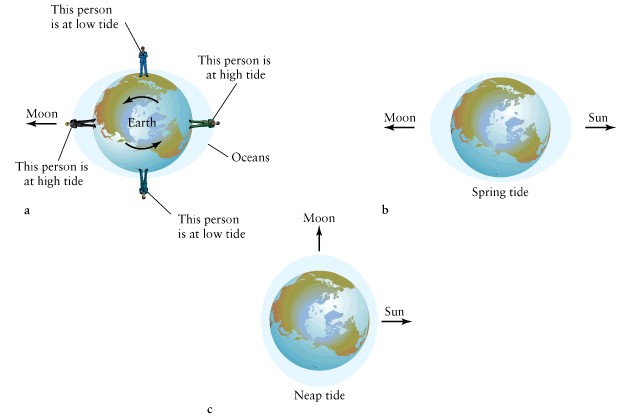
Specifics
about planets + Sun
-
Sun
-
Granules
on Sun caused by convection
-
Sunspots
caused by wound up magnetic field
-
number
of spots cycle every 11 years
-
related
to solar prominences and flares
-
solar
flares effect satellites at Earth
-
Sun
steadily releases charged particles the flow outward
-
Solar
Wind
-
source
of particles that cause auroras
-
Mercury
-
Scarps
are long cliffs
-
3-2
spin-orbit coupling
-
Venus
-
About
same size as Earth
-
Covered
in clouds
-
Greenhouse
effect caused by carbon dioxide (CO2)
-
Mars
-
Much
smaller than Earth
-
No
active volcanos
-
No
liquid water now (but used to be)
-
Water
and CO2 ice on surface
-
Jupiter
-
mostly
hydrogen and helium gas/liquid
-
small
rocky core
-
belts
(dark), zones (bright)
-
Galilean
moons (Jupiter)
-
Io's
volcanos are sulfur dioxide (SO2)
-
Saturn
-
rings
are made of snowballs (all outer planets have rings)
-
Titan
may have hydrocarbon (ethane) lakes
-
Uranus
-
rotation
axis tipped at 98 degrees
-
rotates
retrograde (like Venus, Pluto)
-
Neptune
-
internal
heat source (like Jupiter, Saturn) causes more circulation than Uranus
-
Pluto
-
Pluto
and its moon Charon always have the same faces pointed to eachother
Granules
on Sun (close up), Solar prominence


Scarps
on Mercury
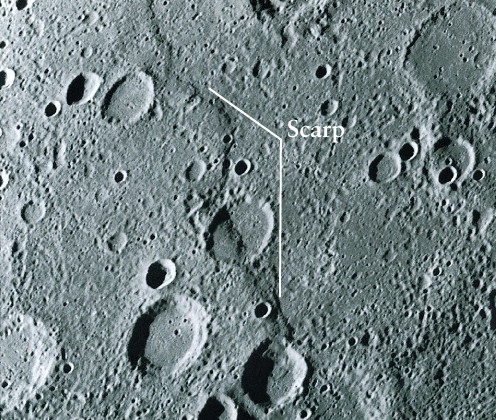

Review
Outline
-
The
big picture
-
The
solar system
-
the
Sun
-
9 planets
-
7 major
moons
-
Why
didn't we just start with Mercury?
-
intro
material
-
scientific
method
-
scientific
notation, units
-
astronomical
nomenclature
-
nature
of light and matter
-
Laws
of orbits, gravity
-
telescopes
-
Formation
of solar system
-
Earth
and moon in detail, other planets, moons by analogy
-
Specifics
about each planet (not quite as important)
-
Surface
features
-
atmosphere
-
internal
structure





































